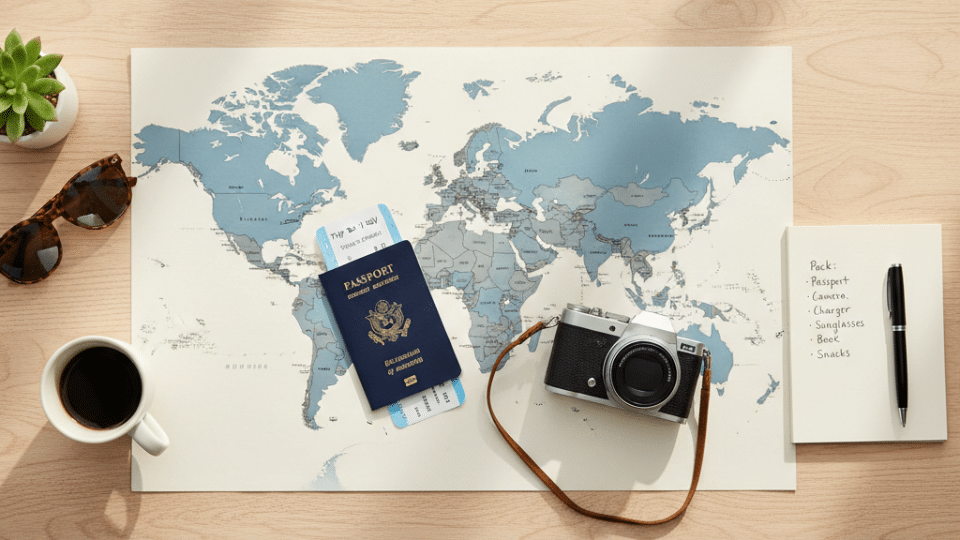Ever felt overwhelmed while trying to organize a trip? You’re not alone.
Between choosing destinations, booking flights, and creating itineraries, travel planning can feel like a full-time job. But it doesn’t have to be complicated or stressful.
In this blog, I’ll show you a complete, step-by-step process for planning any trip with confidence.
Whether you’re dreaming of a weekend getaway or a month-long adventure, this guide will help you organize everything smoothly.
By the end, you’ll have a clear roadmap that takes the guesswork out of travel planning and lets you focus on the excitement of your upcoming journey.
Decide on Your Destination & Travel Dates
Your first step is choosing where and when to go. Start by considering your personal goals. Are you seeking relaxation, adventure, culture, or food experiences? This clarity will help narrow down your options significantly and prevent decision paralysis.
Research Tools That Actually Work:
- TripAdvisor for honest reviews and inspiration
- Lonely Planetfor comprehensive destination guides
- Google Travel for price comparisons and flight deals
- Google Flights’ explore feature for discovering budget-friendly options you never considered
Weather matters more than you think. Check seasonal patterns for your preferred travel dates, as the climate can significantly impact your experience.
Shoulder seasons (spring and fall) often offer the perfect sweet spot of pleasant weather and lower costs.
Consider the practical stuff too. How much time can you realistically take off work? What’s your comfort level with international travel? Are there visa requirements or health restrictions?
These factors will help you create a shortlist of destinations that actually work for your situation, not just your dreams.
Set a Realistic Budget
Smart budgeting is the foundation of stress-free travel. Most people underestimate costs and end up either overspending or missing out on experiences. Break your budget down into clear categories to see exactly where your money is going.
| Category | Typical % | $2000 Trip | What’s Included |
|---|---|---|---|
| Transportation | 25-40% | $500-800 | Flights, airport transfers, local transit, and car rentals |
| Accommodation | 25-35% | $500-700 | Hotels, Airbnb, hostels, resort fees, taxes |
| Food | 20-30% | $400-600 | Restaurants, street food, groceries, drinks |
| Activities | 10-20% | $200-400 | Tours, attractions, entertainment, experiences |
| Shopping/Misc | 5-15% | $100-300 | Souvenirs, tips, emergency expenses, WiFi |
How to Plan a Trip on a Budget, Priority Order
When learning how to plan a trip on a budget, focus on four key factors. Flight timing is your biggest budget factor; booking strategically versus last-minute saves hundreds or thousands.
Accommodation location matters next, as city center costs are double those of suburban rates. Destination choice shapes everything since Southeast Asia costs dramatically less than Switzerland.
The travel season affects all prices. Peak costs are 50-100% higher than those during the shoulder season. Always add a 10-15% buffer for unexpected expenses and use Numbeo, Rome2Rio, and XE Currency for accurate cost research.
Create a Trip Planning Checklist
Organization prevents those 2 AM panic moments when you realize you forgot something important. Focus on essentials that could genuinely ruin your trip if missed—you don’t need a 47-point checklist.
1. Essential Documents
Ensure your passport has at least 6 months remaining before expiration, as many countries won’t allow entry otherwise. Research visa requirements early and apply well in advance since processing can take weeks.
Purchase travel insurance, especially for expensive or international trips where medical costs could be astronomical. Include your driver’s license or international driving permit if you plan to rent a car.
2. Critical Bookings
Confirm flights and secure seat assignments to avoid unwanted middle seats or separation from companions. Reserve accommodation and save confirmation numbers in an easily accessible location.
Arrange airport transfers or local transportation to avoid being stranded upon arrival. Book must-do activities and popular restaurants in advance since they fill up weeks ahead.
3. Health & Safety
Update vaccinations according to destination requirements and CDC recommendations. Pack medications with extra supplies in carry-on luggage in case checked bags get delayed.
Create an emergency contacts list, including local emergency numbers for your destination. Store document copies separately from originals and back them up in accessible cloud storage.
4. Financial Preparation
Notify banks about travel plans to prevent automatic card blocks during overseas purchases. Prepare a strategic mix of payment methods, including credit cards, debit cards, and appropriate cash.
Download a budget tracking app to monitor spending in real-time. Research current exchange rates to understand the true cost of purchases abroad.
5. Pre-Departure Essentials
Check weather forecasts to pack appropriately for the climate and season. Research local customs and etiquette to avoid cultural mistakes and show respect.
Save important phone numbers, including hotel, emergency services, and transportation contacts. Keep travel insurance contact information easily accessible for potential claims.
Many travelers find a trip planning checklist PDF helpful for staying organized. You can create your own template or download one that matches your travel style and destination needs.
Book Your Flights and Accommodation
Timing is everything in travel booking. Book too early and you might miss better deals; book too late and you’ll pay premium prices or face limited availability.
- Time It Right: Domestic flights: 1-3 months ahead. International: 2-6 months ahead. Peak season: Add 1-2 months extra.
- Fly Smarter, Not Harder: Book Tuesday/Wednesday departures for 10-15% savings. Choose flights for early morning or late evening departures. Stay flexible with dates to unlock hidden deals.
- Location vs. Luxury Decision: Prioritize walkable neighborhoods for cultural immersion. Choose amenities for relaxation trips. Pick social spots for solo travel connections.
- Platform Power Play: Booking.com for flexibility. Airbnb for unique stays. Hostelworld for budget social vibes. Expedia for package deals.
- Research Before You Book: Read 6-month recent reviews only. Check cancellation policies twice. Pay 10-20% extra for flexible bookings, it’s worth it.
Smart booking isn’t about finding the cheapest option; it’s about finding the best value for your specific travel style and budget.
Plan Your Itinerary

The best itineraries balance must-see attractions with breathing room for spontaneous discoveries. Over-scheduling is the fastest way to turn a vacation into an exhausting checklist.
Morning: Peak Energy Hours
Schedule one major activity or attraction during your highest energy period when you’re mentally sharp and physically fresh.
This is perfect for physically demanding activities like hiking mountain trails, extensive museum visits, or early morning tours when crowds are smaller and the weather is cooler.
The morning hours also offer the best photography lighting and authentic experiences at local markets before the arrival of tourist crowds.
Afternoon: Flexible Exploration Time
Use this period for secondary activities, leisurely neighborhood exploration, or strategic rest time when energy naturally dips.
Consider indoor activities like museums or cafes if you’re in a hot climate, or cultural experiences like cooking classes and art galleries that don’t require peak energy.
This time works well for travel days between cities, checking into accommodations, or food tours that can be adjusted based on weather and mood.
Evening: Cultural Immersion
Reserve evenings for relaxed dining experiences, local nightlife, cultural performances, or sunset activities when destinations come alive with authentic local energy. This is prime time for rooftop bars, night markets, street food adventures, and socializing with locals.
Evening hours offer unique experiences like sunset viewpoints, cultural shows, and illuminated architecture that showcase destinations’ different nighttime personalities.
Smart Planning Principles:
- Leave 40% unplanned time. The best travel memories often come from unexpected discoveries and spontaneous conversations
- Group nearby activities. Minimize travel time and transportation costs by clustering geographically close attractions
- Research transportation passes. Many cities offer tourist cards that bundle transit and attraction discounts for significant savings
- Build in recovery time. Avoid scheduling intensive activities immediately after long flights or exhausting days
- Check opening schedules. Verify days, hours, and seasonal closures to prevent disappointing arrival at closed attractions
The Balance Formula: Book popular experiences in advance, but leave 40% of your time unplanned for recommendations from locals and fellow travelers you’ll meet along the way.
Final Thoughts
Planning a trip doesn’t have to be stressful when you follow a step-by-step process. Start with destination, dates, and budget, then work through each phase without getting overwhelmed.
Perfect planning isn’t the goal; smart preparation is. Secure your flights, accommodation, and must-do activities, then leave space for spontaneous discoveries that make travel memorable.
Start early, stay organized, and use comparison tools to streamline booking. Don’t let planning consume more energy than the actual trip.
Your next step: Pick one wishlist destination and start today.
What destination is calling you? Share your travel planning tips in the comments below—I’d love to help with any planning challenges you’re facing.





































